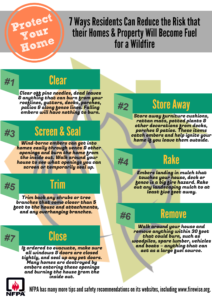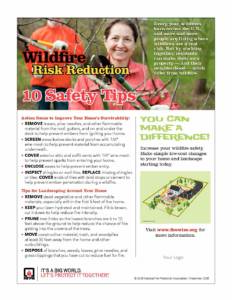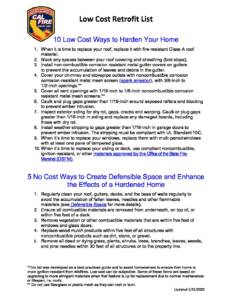Fire Resistant Roofing
 The roof is the most vulnerable part of your home. Homes with wood or shingle roofs are at high risk of being destroyed during a wildfire. Build your roof or re-roof with materials such as composition, metal or tile. Block any spaces between roof decking and covering to prevent embers from catching.
The roof is the most vulnerable part of your home. Homes with wood or shingle roofs are at high risk of being destroyed during a wildfire. Build your roof or re-roof with materials such as composition, metal or tile. Block any spaces between roof decking and covering to prevent embers from catching.
ROOF COVERINGS AND ASSEMBLIES
Roof covering fire ratings are Class A, B, C, or unrated; with Class A providing the best performance. Common Class A roof coverings include asphalt fiberglass composition shingles, concrete, and flat/barrel-shaped tiles. Some materials have a “by assembly” Class A fire rating which means, additional materials must be used between the roof covering and sheathing to attain that rating. Examples of roof coverings with a “by assembly” fire rating include aluminum, recycled plastic and rubber, and some fire-retardant wood shake products. If a wood shake roof does not have the manufacturer’s documentation specifying the fire retardant, assume it’s untreated.
TILE AND ROOF COVERINGS WITH GAPS BETWEEN THE COVERING AND ROOF DECK
Flat and barrel-shaped tiles, metal, and cement roof coverings can have gaps between the roof covering and sheathing, which typically occur at the ridge and edge of roofs. These openings can allow birds and rodents to build nests with materials that are easily ignited by embers. Flames from this type of ignited debris can spread to the structural support members, bypassing the protection offered by a Class A rated roof covering. Plugging these openings between the roof covering and the roof deck, is commonly called “bird stopping”. Regularly inspect and maintain these areas.
DEBRIS ACCUMULATION – ROOF AND GUTTERS
Wind-blown debris (including leaves and pine needles from nearby and overhanging trees) will accumulate on roofs and in gutters. Dry debris can be ignited by wind-blown embers. These flames can extend to the edge of the roof and adjacent siding. Even with Class A fire-rated roof coverings, vertical surfaces next to the roof edge will be exposed to flames from the ignited debris. Regularly remove vegetative debris from your roof and gutters.
REPLACE YOUR ROOF COVERING
If your roof has reached the end of its service life, it should be replaced. IBHS recommends hiring a professional roofing contractor to replace or repair your roof covering.
If you have an untreated wood shake roof, the only solution for reducing your wildfire risk is to replace it with a rated roof covering. Regardless of your fire hazard, given that many Class A roof coverings are available, IBHS recommends installing a Class A covering if you are living in a wildfire-prone area.
The roof covering and edge are the most vulnerable part of a home. Because of its large, relatively horizontal surface, the roof has the most severe exposure to all elements, including sun and rain, and during a wildfire, embers. Because of these exposures, roof coverings tend to require more maintenance and typically have a shorter service life than other construction materials used on the outside of homes.
Fire ratings for roofs provide a measure of the amount of protection. Class A provides the highest protection and Class C the lowest. At a minimum, unrated roofs, such as an untreated wood shake roof, should be replaced by a rated roof. Class A roofs are commonly available and can be very affordable, so they can be well worth the cost. Regardless of roof type, it should be kept in good condition and free of combustible debris. Your local building and fire departments would know about any special requirements that may apply to your community.
 Roofing materials can obtain a Class A rating based on the covering alone (a stand-alone Class A covering) or the covering and an underlying material used to enhance fire performance (Class A by assembly). The fire rating for roof coverings is determined by following a standard test procedure developed by the American Society for Testing and Materials (ASTM), called the Standard Test Method E-108. This test evaluates flame spread over the roof covering, the ease with which fire can penetrate through the roof (and into the attic or ceiling space), and the ember generation potential of the roof covering. If flame spread is too large, or if fire penetrates through the roof covering and underlying construction materials, the covering cannot be considered Class A.
Roofing materials can obtain a Class A rating based on the covering alone (a stand-alone Class A covering) or the covering and an underlying material used to enhance fire performance (Class A by assembly). The fire rating for roof coverings is determined by following a standard test procedure developed by the American Society for Testing and Materials (ASTM), called the Standard Test Method E-108. This test evaluates flame spread over the roof covering, the ease with which fire can penetrate through the roof (and into the attic or ceiling space), and the ember generation potential of the roof covering. If flame spread is too large, or if fire penetrates through the roof covering and underlying construction materials, the covering cannot be considered Class A.
When using an assembly-rated Class A covering, make sure that all installation instructions are followed and all specified materials are used. The fire performance of the assembly may be reduced if installation procedures are modified or materials other than those specified are substituted.
 Many non-combustible roofing materials receive a stand-alone Class A rating by meeting the noncombustible definition as provided in the building code; therefore, they do not need to be tested to the ASTM E-108 standard and given a fire-resistant rating (e.g., a Class A, Class B, or Class C fire-resistant rating). An exception to this general rule is an aluminum covering. Because of its low melting point, it must be tested. Installation instructions will include use of an additional material under the aluminum covering in order to receive the Class A (by assembly) rating.
Many non-combustible roofing materials receive a stand-alone Class A rating by meeting the noncombustible definition as provided in the building code; therefore, they do not need to be tested to the ASTM E-108 standard and given a fire-resistant rating (e.g., a Class A, Class B, or Class C fire-resistant rating). An exception to this general rule is an aluminum covering. Because of its low melting point, it must be tested. Installation instructions will include use of an additional material under the aluminum covering in order to receive the Class A (by assembly) rating.
Wood shakes treated with a pressure-impregnated, fire-retardant chemical can achieve a Class A assembly rating. In California, wood shakes treated with a fire retardant must pass a natural weathering exposure test to be approved for use by the Office of the State Fire Marshal (OSFM). Wood shakes approved for use in California must be registered with the OSFM Building Materials Listing Program. In some communities within and outside of California, wood shakes and shingles treated with fire retardants are not allowed.
 A complex roof provides an additional level of vulnerability. The term complex indicates that there are a number of horizontal- to-vertical intersections on the roof that could make a Class A roof more vulnerable to wildfire, and in particular to an ember exposure. From a fire performance perspective, these intersections provide collection points for windblown debris (e.g., pine needles and other vegetation), debris from overhanging trees, and—during a wildfire—windblown embers. These locations are also where different construction materials with different fire vulnerabilities will be present on the respective surfaces. If ignited, the flames from the burning vegetative debris would provide a flame contact exposure on the siding material, the roof sheathing or soffit material, or even a window. The vulnerability of these components will depend on material selection and other design considerations. Particularly with a Class A roof, it will be the fire resistance of the siding, sheathing, or window that will determine the vulnerability of the complex roof, not the roof covering itself.
A complex roof provides an additional level of vulnerability. The term complex indicates that there are a number of horizontal- to-vertical intersections on the roof that could make a Class A roof more vulnerable to wildfire, and in particular to an ember exposure. From a fire performance perspective, these intersections provide collection points for windblown debris (e.g., pine needles and other vegetation), debris from overhanging trees, and—during a wildfire—windblown embers. These locations are also where different construction materials with different fire vulnerabilities will be present on the respective surfaces. If ignited, the flames from the burning vegetative debris would provide a flame contact exposure on the siding material, the roof sheathing or soffit material, or even a window. The vulnerability of these components will depend on material selection and other design considerations. Particularly with a Class A roof, it will be the fire resistance of the siding, sheathing, or window that will determine the vulnerability of the complex roof, not the roof covering itself.
SKYLIGHTS
 Skylights typically cover a small portion of the roof, but they can still provide an entry point for wildfire. Flat skylights contain tempered glass. Domed skylights have a plastic outer shell, usually with an inner layer of flat glass. In domed skylights that can be opened (i.e., they are operable), screening is sometimes used instead of the flat glass layer.
Skylights typically cover a small portion of the roof, but they can still provide an entry point for wildfire. Flat skylights contain tempered glass. Domed skylights have a plastic outer shell, usually with an inner layer of flat glass. In domed skylights that can be opened (i.e., they are operable), screening is sometimes used instead of the flat glass layer.
If you have an operable skylight, make sure it is closed during a wildfire in order to avoid the entry of burning and glowing embers. None of these configurations could pass a standard Class A fire exposure test used to evaluate roofing materials. To understand the potential vulnerability of your skylights, you should consider the slope of the roof, the location of nearby combustible materials, and the location of accumulated debris on and around the skylights. If your roof has a steep pitch, the skylight would receive more radiant heat from nearby burning vegetation or buildings, and glass may break or plastic deform. As always, it is better to keep debris cleared away from the skylight. Normally debris will not accumulate on the domed skylights, but it can on the flat skylights, particularly on lower sloped roofs. Debris can also accumulate at the edge of skylights. If that debris were to ignite, then the materials and connections at the roof-to-skylight intersection would be vulnerable, so it is important to clear debris on a regular basis. Vegetation management should also be part of your solution. Overhanging tree branches should be removed since a broken branch could fall and break the skylight.
ROOF EDGES
The roof edge is vulnerable to wildfire exposures in two ways. The first is when you have a debris-filled rain gutter located adjacent to the roof edge. The second occurs with roofing profiles where the design results in large gaps between the roof covering and the roof sheathing. A common example of this is barrel-design clay tiles. The gaps typically occur at the roof edge, but can also occur at the roof ridge (peak). In both, an ember exposure would be the most important ignition source.
RAIN GUTTERS
 When ignited by embers, the burning debris in the gutter will provide a flame contact exposure to the edge of the roof. The protection provided by the roof edge must be sufficient to resist the entry of flames into the attic space or cathedral ceiling. The roof edge must also protect against the ignition of the exposed roof sheathing or the exposed fascia board. The exposure is more severe if metal angle flashing is not used at the roof edge and if the gutter is hung below the roof edge, leaving the roof sheathing exposed.
When ignited by embers, the burning debris in the gutter will provide a flame contact exposure to the edge of the roof. The protection provided by the roof edge must be sufficient to resist the entry of flames into the attic space or cathedral ceiling. The roof edge must also protect against the ignition of the exposed roof sheathing or the exposed fascia board. The exposure is more severe if metal angle flashing is not used at the roof edge and if the gutter is hung below the roof edge, leaving the roof sheathing exposed.
The most important thing you can do for the gutter is to keep it clear of debris. This debris can be readily ignited by embers during a wildfire. The material that the gutter is made from is less important. A metal (noncombustible) gutter will stay in place while the debris burns and the resulting flames will impinge on the edge of your roof (not your Class A roof covering, but the edge of it).
The vulnerability of the roof edge will depend on materials used and how well the flashing if used, protects the edge. On the other hand, a vinyl (plastic) gutter will quickly melt, detach, and fall to the ground (Jennings 2000). The burning debris will fall with it and continue to burn on the ground. Once on the ground, the roof edge is no longer exposed to flames, but combustible siding may be, particularly if the near-home vegetation or ground cover can easily ignite. The problem with gutters is that the debris can accumulate in them. Keep debris out of them, and the problem goes away. Inspection and removal of debris in gutters should be done before fire season and as necessary thereafter. Since debris, just like burning embers, can be blown in from surrounding areas, a good vegetation management ( fuel reduction) plan around your property can reduce, though not eliminate, the accumulation of debris in gutters. A pre-evacuation task that would alleviate the problem of some debris accumulation in a gutter would be to plug the downspouts and fill the gutter with water. The downspouts would be uncovered upon returning home.
Given the potential problems with gutters, why not just do away with them? Properly installed and maintained gutters and downspouts play an important moisture-management role for a building by collecting and moving water to where it will not have a negative (moisture- related) impact on the foundation and crawl space. (A properly installed subsurface drainage system, however, could alleviate the need for gutters.)
A number of gutter cover devices are commercially available. These products are intended to limit the accumulation of debris in the gutter and allow for the free flow of water into and out of them. These devices either cover the gutter with a solid material or screen or fill the gutter with a porous (foam) material. There is variability in the cover devices, including those that 1) incorporate a screen that completely covers the gutter, 2) incorporate a solid, thin metal sheet that covers the gutter but has an opening at the outside edge to allow water to enter, or 3) use a hybrid metal cover/louvered design. The solid, thin metal cover relies on the surface tension of water, releasing from the rounded metal edge of the cover to drop into the gutter. The porous foam devices allow water to enter and flow through the gutter while excluding debris larger than the pores. A procedure to evaluate the performance of these devices has not been developed, so if you are consider- ing one of them, review the available literature that represents a range of designs and look at devices installed on nearby homes. The devices require maintenance – with some there is a tendency for debris to accumulate on the roof behind the device, which you should remove. None of the available devices is likely to be completely maintenance-free.
Resource credit: CAL FIRE, California Fire Safe Council and FIRESafe MARIN
Resources
- Home Survival in Wildfire-Prone Areas: Building Materials and Design Considerations: ANR Publication 8393 6
- Home Landscaping for Fire. University of California Publication 8228. 2007. University of California, Davis.
- www.readyforwildfire.org. Wildfire is Coming: Are You Ready. CAL FIRE. 2012.
- Urban Forestry Associates. Ray Moritz, Urban Forester and Fire Ecologist.
- Protecting Your Home From Wildfire. 2017. Insurance Institute for Business & Home Safety
PREPAREDNESS MENU
Prepare your Home
RESOURCES
Seven ways residents can reduce wildfire risk infographic by NFPA
Download the free wildfire safety infographic with seven tips for residents to help protect their homes in an event of a wildfire.
Wildfire risk reduction safety tips by NFPA
By working together, residents can make their own property, and their neighborhood, much safer from wildfire.
10 Low-Cost Retrofits by Cal Fire



